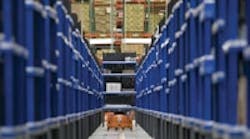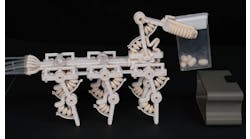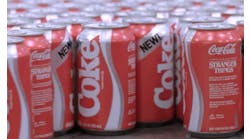Want to experience the role of robots in lean manufacturing up close and personal? Visit the warehouses of retailers Staples Inc. or Zappos.com, where hundreds of armless, mobile robots automate the storage and retrieval processes. The robot supplier in both instances is Kiva Systems Inc.
At Staples' Chambersburg, Pa., warehouse, the armless wonders increase productivity as gofers for order fulfillment operators. Output per operator has reportedly tripled. For example, operators can now stay at their workstations as the robotic gofers roam the 500,000-square foot plant to seek and deliver the individual shelving pods containing the product needed for shipment. The operator removes the part and the robot returns the inventory pod.
Meanwhile at Zappos' Shepherdsville, Ky., warehouse, it is the implementation time savings of the Kiva automation solution that has impressed management. In just four months Zappos has deployed a fleet of Kiva mobile robotic drive units and inventory storage pods.
"Virtually all of the previous automation system deployments I've seen took a year or more to design, build and test," says Craig Adkins, vice president of fulfillment operations for Zappos. "We were amazed that Kiva transformed our new warehouse from bare concrete to fully operational readiness -- with trained supervisors and associates -- just four months after we signed the purchase order. We're already working on designs to cube out the building with Kiva's mobile fulfillment system (MFS) on the multi-level mezzanines."
"In contrast, the Kiva system is fully mobile, with none of its major elements bolted to the walls or floor," explains Rosenberg. As a result the robotic approach can be easily reconfigured to accommodate capacity changes or the need to store, move or sort a new range of products.
With the emphasis on e-commerce orders requiring split-case picking, the Zappos distribution center needs to manage a huge range of unique products, while shipping orders as quickly as possible. The Kiva MFS effectively empowers inventory to manage itself, and transforms the distribution center from a serial-process operation to a massively parallel processing order fulfillment engine, says Adkins. As a result, Zappos gains breakthrough improvements over generally accepted material handling benchmarks. These include order picking speed and accuracy, volume scalability and flexibility in reconfiguring operations or responding to marketing changes, adds Adkins.
See Also



